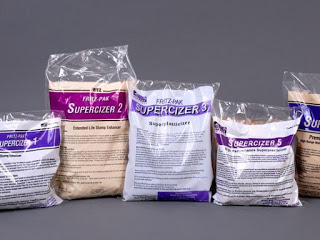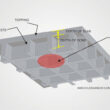Materials added to concrete during or before mixing are referred to as admixtures. They are used to improve the performance of concrete in certain situations as well as to lower its cost. There is a rather well-known saying regarding admixtures, to the effect that
 |
| Different Types of Admixtures |
“they are to concrete as beauty aids are to the populace.”
An admixture can be defined as :-
A chemical product which, except in special cases, is added to the concrete mix in quantities no larger than 5 percent by mass of cement during mixing or during an additional mixing operation prior to the placing of concrete, for the purpose of achieving a specific modification, or modifications, to the normal properties of concrete.
Admixtures, unlike cement, aggregate and water, are not an essential component of the concrete mix, they are an important and increasingly widespread component; in many countries a mix which contains no admixtures is nowadays an exception.
Benefits / Advantages of Admixtures
They are capable of imparting considerable physical and economic benefits with respect to concrete. These benefits include use of concrete under circumstances where previously there were considerable difficulties. They also make possible the use of a wide range of ingredients in the mix.
Admixtures although are not always cheap but they do not necessarily represent additional expenditure because their use can result in economical savings.
Classification and Types of Admixtures
Admixtures are classified according to ASTM C 494-10 as follows :-
- Type A – Water reducing
- Type B Retarding
- Type C – Accelerating
- Type D – Water-reducing and retarding
- Type E – Water reducing and accelerating
- Type F – High range water-reducing or superplasticizing
- Type G – High range water reducing and retarding or superplasticizing and retarding
Air-Entertaining Admixtures
Conforming to the requirements of ASTM C260 and C618, are used primarily to increase concrete’s resistance to freezing and thawing and provide better resistance to the deteriorating action of de-icing salts. The air-entraining agents cause the mixing water to foam, with the result that billion of closely spaced air bubbles are incorporated into the concrete. When concrete freezes, water moves into air bubbles, relieving the pressure in the concrete. When the concrete thaws, the water can move out of the bubbles, with the result that there is less cracking than if air-entrainment had not been used.
Accelerating Admixtures
The addition of accelerating admixtures such as calcium chloride to concrete will accelerate its early-strength development. The results of such additions (particularly useful in cold climates) are reduced times required for curing and protection of the concrete and earlier removal of forms. Other accelerating admixtures that may be used include various soluble salts as well as some other organic compounds.
Retarding admixtures
Are used to slow the setting of the concrete and to retard temperature increases. They consists of various acids or sugars or sugar derivatives. Some concrete truck drivers keep sacks of sugar on hand to throw into the concrete in case they get caught in traffic jams or otherwise delayed. Retarding admixtures are particularly useful for large pours where significant temperature increases may occur. they also prolong the plasticity of the concrete, enabling better blending or bonding together of successive pours.
Superplasticizers
They are admixtures made from organic sulfonates. Their use enables engineers to reduce the water content in concretes substantially while at the same time increasing their slumps. Although superplasticizers can also be used to keep constant water-cement ratios while using less cement, they are more commonly use to produce workable concretes with considerably higher strengths while using the same amount of cement.
Water proofing materials
Are applied to hardened concrete surfaces, but they may be added to concrete mixes. These admixtures generally consist of some type of soap or petroleum products, as perhaps asphalt emulsions. They may help retard the penetration of water into porous concretes but probably don’t help dense, well-cured concrete very much.


















